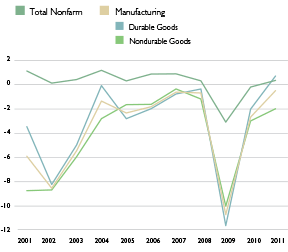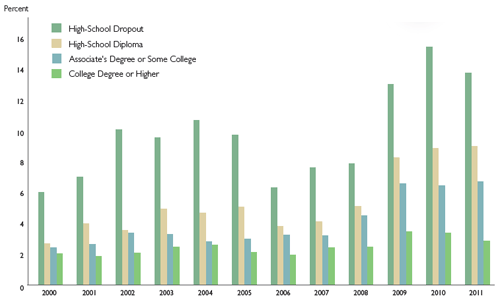Moving Skills from Low to High 
After job losses in manufacturing, a new program to give workers the skills most in demand at companies in Maine has been a win-win-win for workers, employers, and communities.
Over recent decades, Maine has suffered tremendous losses in manufacturing, traditionally a reliable job provider and an important part of Maine's identity. Statistics for 2000 to 2008 alone show more than 6,000 manufacturing jobs lost.[1] Textile mills, fine paper and pulp mills, shoe factories, and even seafood-processing employers have moved operations offshore to reduce costs. (See "Employment in Maine.")
In their wake are workers who dedicated their entire adult lives to factory work. The old system of following a parent's footsteps into the factory is gone. And many unemployed or underemployed Mainers lack the newer, more marketable skills required for gainful employment. Meanwhile, employers eager for a workforce with updated knowledge and skills struggle to find qualified applicants.
Maine Tackles Skills Mismatch
The skills challenge is particularly severe for Maine's rural, mostly low-income, population. Underemployed adults, some with obsolete factory skills, work numerous jobs to make ends meet. Although many would like to take advantage of new job opportunities, they lack updated knowledge. Moreover, they are finding it nearly impossible to afford the cost of training and education. Whether the training they seek is truckdriving lessons through a commercial driver's license training program or a two-year nursing degree from a community college, the cost is out of reach for many.

Photograph: iStockphoto
Lack of access to educational opportunities is keeping many residents from becoming marketable job seekers while hampering employers' ability to recruit people. With that concern in mind, Maine's legislature created the Competitive Skills Scholarship Program (CSSP) with enthusiastic bipartisan support. CSSP was launched January 1, 2008, with three goals: first, to give individuals access to education, training, and support leading to jobs in anticipated high-demand sectors; second, to improve the economic well-being of the participants in the program; finally, to provide employers with a skilled labor force.
A CSSP Fund (CSSF) was established by the CSSP statute, requiring a plan for an annual yield. The funds are raised through an annual employer assessment based on worker earnings. The assessment is equal to .02 percent of the total wages paid by each contributing employer, subject to unemployment insurance taxes. The formula is expected to yield approximately $3 million annually. Through the fund, CSSP is able to cover the cost of tuition, fees, books, required supplies, and tools—plus the supportive services without which participants might not be able to complete program successfully.
CSSP is administered by the Bureau of Employment Services (BES) within Maine's Department of Labor. Each of Maine's 16 counties is apportioned a set number of slots based on the federal Workforce Investment Act program's year-allocation fund. When determining the number of participants that can be accepted into the program in a given year, BES takes into account how many participants from the prior year are still in training. The average participant enrollment is 3.39 years. CSSP rules allow a participant to take four years to finish a two-year program if circumstances require.
Employment in Maine Percent Change from Year Earlier (seasonally adjusted)

Source: U.S. Bureau of Labor Statistics
To be eligible, applicants must be at least 18; lack a marketable postsecondary degree; have income less than 200 percent of the federal poverty level for the family size involved; apply for education or training for a job in an approved industry offering high wages and high demand; and have the aptitude to complete the training, as determined by the institution providing it.
Applications submitted to the local career centers in each county are reviewed for initial eligibility, and applicants considered eligible are placed on a list for selection in an electronic randomizing process. Selected participants are paired with a caseworker at their career center, and an individual career plan or Individual Service Strategy (ISS) is designed. In effect, the ISS is a goals-and-service contract between the participant and CSSP.
Participant Characteristics
By September 30, 2011, CSSP had 637 people enrolled. Active participants numbered 407. A review of case-management data on the 637 shows that two-thirds were female; the average age was 35.8 (ranging from 18 to 73); the average household size was 2.3 persons; and 32 percent were single parents.
The income and employment status reported by the 637 suggests a struggle to get by:
- 71.2 percent had household income below the poverty level ($14,710 annually for a household of two), well below the eligibility limit (200 percent of the federally mandated poverty level for 2011);
- 23.7 percent reported hourly wages between $8 and $9.99;
- 71.0 percent were unemployed at the time of application;
- 37.0 percent reported receiving unemployment benefits at the time of application;
- The most recent annual wages for 92.0 percent of enrollees were less than $28,621;
- 63.4 percent earned wages below $11.20 per hour; and
- The average hourly wage for the most recent wages of enrollees was $11.53, well below the statewide average of $17.62.
CSSP participants are registered for courses ranging from short-term certificate classes to four-year degree programs:
- Of the 637, 13 percent enrolled in developmental courses in the adult education system;
- 26 percent enrolled in certificate or one year degree programs at approved institutions;
- 47 percent enrolled in two-year degree programs, primarily in community colleges or the University of Maine system; and
- 35 percent enrolled in four-year degree programs, mostly in the University of Maine system.[2]
The projected wage in occupations selected by the 637 CSSP participants--for example, registered nursing, truck driving, mental health counseling, and computer support specialties--is $23.03 per hour, or $47,902 annually, for full time. That would, on average, more than double their income.
Today employers want the more educated, better trained job seekers. The CSSP aims to instill competencies that are the most important: critical thinking, problem solving, analytic skills, communication, interpersonal skills, collaboration, ability to execute, flexibility, adaptability, information processing, and capacity for change.[3]
The intangible benefits of education and training are equally important. A recent news article about a participant illustrates how participation in postsecondary education can affect a life:
"I worked as a mechanic until I lost my job. I always liked computers, so I went back to school, got some training, and now work in IT for Central Maine Community College making more money than I did before." He credits his journey from anxious and unemployed to happy and employed to the Lewiston Career Center, the Competitive Skill Scholarship Program and Central Maine Community College.[4]
For adults with a history of low-wage work and unemployment, CSSP can improve quality of life and heighten aspirations for families. (See "Unemployment by Educational Attainment.")
The open application period for CSSP 2012 was in early February. By March 1, CareerCenters had processed 901 applications for eligibility. On March 15, the list went through a random-selection process, and winners were identified on the basis of allocated slots per county. Two weeks later, CareerCenter counselors were sitting with 150 new CSSP participants designing plans for study and support.
Unemployment by Education Attainment, State of Maine

Source: Current Population Survey (CPS), http://thedataweb.rm.census.gov/ftp/cps_ftp.html , and Federal Reserve Bank of Boston.
Analysis of participants' training choices in light of projected job openings indicates that the program is successfully connecting people to training for projected in-demand jobs. More education and training increase their chances of obtaining and keeping jobs that pay well and help them advance. Maine data, along with participant feedback, show that CSSP is carrying out its legislative mandate to improve the economic well-being of the participants and to provide employers with skilled workers.
Jorge A. Acero, is the Competitive Skills Scholarship Program manager at the Maine Bureau of Employment Services. Contact him at Jorge.A.Acero@Maine.gov.
Endnotes
[1] John Dorrer, "CSSP 2009-2010 Enrollment Profile, November 1, 2007 -- June 2010" (white paper, Maine Department of Labor, Augusta, Maine, 2010).
[Return to endnote in story]
[2] Many participants in developmental courses were simultaneously in courses providing credit, and others continue to transition from two-year degrees to four-year degrees. Thus the numbers include duplicates, and the sum of participants is greater than the 637 actual headcount.
[Return to endnote in story]
[3] Luisa Depre and Sandra S. Butler, "Independent Participant Overview," 2011 Report of CSSP to Joint Standing Committee on Labor, Commerce, Research and Economic Development (Augusta, Maine: Maine Department of Labor, 2012).
[Return to endnote in story]
[4] Bonnie Washuk, "Unemployment Leads to New Career in IT," Lewiston-Auburn Sun Journal, July 26, 2010, http://www.sunjournal.com/city/ story/880564 .
[Return to endnote in story]
When Job Openings Don't Match Available Skills
by Julia Dennett, Federal Reserve Bank of Boston
Policymakers and business leaders across New England are concerned that the region is facing a shortage of skilled labor, particularly as baby boomers retire. If New England lacks a sufficient number of workers or if the population does not have the right mix of skills, businesses will be unable to locate to the region or expand, impeding long-term growth.
Recent New England Public Policy Center research suggests that the gap between the skill level of the population and the skills demanded by employers is greatest in occupations classified as middle skill. Middleskill jobs are jobs requiring some postsecondary education beyond high school, such as an associate's degree or other college training, but less than a bachelor's degree. They often entail specialized skills or interpersonal interactions in sectors such as health care, advanced manufacturing, education, and information technology.
NEPPC findings indicate that the supply of middle-skill workers has not kept pace with demand for several decades and will likely face future constraints. Meanwhile, firms continue to require ever greater levels of education and training.
Policymakers should consider implementing education and training programs to fill positions in growing categories of middle-skill jobs. Twoyear educational institutions such as community colleges, the primary source of education and training for middle-skill workers, can be good partners for companies. In addition to offering access to postsecondary coursework, they increasingly provide training opportunities, including vocational certificates, remedial education, and English as a Second Language.
Julia Dennett, a research associate in the New England Public Policy Center of the Federal Reserve Bank of Boston, collaborated on "The Middle-Skills Gap: Ensuring an Adequate Supply of Skilled Labor in Northern and Southern New England" with economist Alicia Sasser Modestino. Contact Julia.Dennett@bos.frb.org or read the paper at http://www.bostonfed.org/economic/neppc/briefs/2011/pb111.htm.
Articles may be reprinted if Communities & Banking and the author are credited and the following disclaimer is used: "The views expressed are not necessarily those of the Federal Reserve Bank of Boston or the Federal Reserve System. Information about organizations and upcoming events is strictly informational and not an endorsement."

 About the Authors
About the Authors
Jorge A. Acero, Maine Bureau of Employment Services



